The automotive industry is racing towards electric vehicles | ZDNet
The future of electric vehicles and the changing experiences per mile
Are experiences per mile different for electric vehicle (EV) owners? This is the question that was answered in a report published by the Experience Per Mile (EPM) Advisory Council which I am a member of. The role of the EPM advisory council is to enable a more consumer-centric vision of the future of driving experience, developing the foundation for positive and successful experiences moving forward.
HARMAN and SBD Automotive, together with industry partners and stakeholders, is transforming the industry and media dialogue through the recently formed Experiences Per Mile Advisory Council. The purpose of the council is to align automakers, Tier-one suppliers, third-party providers, and other industry leaders, and to encourage collaboration regarding the changing value chains in the automotive industry that are being driven by the connected movement. The most recent focus for the EPM advisory council was the future of experience in EVs with two fundamental assumptions:
1. Adoption of EVs will proliferate
2. The charging infrastructure will catch up and meet the level of demand.

Year-over-Year BEV sales growth and key market drivers
Traditional carmakers are committed to electric vehicles
Globally, there has been fast growth in the premium sectors as OEMs have focused on customers that are less price sensitive. The report finds that traditional OEMs (original equipment manufactures) are feeling the pressure from early movers such as Tesla. Traditional carmakers are also looking to increase control over the EV value chain, with a focus on key components like batteries. The 2021 EV global market share forecast of < 2% of non-traditional OEMs is expected to rise to 4% by 2030, per LMC Automotive. The report highlights the EV value chain complexity including integration with electrical energy infrastructure, end-of-life component considerations and government entities. Governments are stepping in around the globe to support regional emission targets through an array of legislative approaches. The report notes: “New York, similar to California, is close to passing an ICE sales ban that requires all new passenger vehicle sales to be zero emissions by 2035. This is in-line with the UK’s ban that was moved up from 2040 to 2035, and the European Commission’s recently announced EU-wide ICE (internal combustion engine) ban in 2035 with the aim for “almost 100%” of cars on the roads in 2050 to be free from tailpipe emissions.”
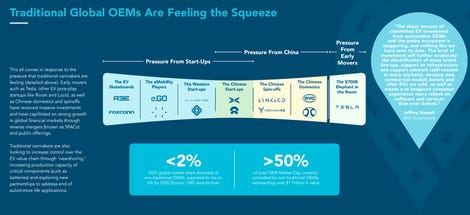
Traditional carmakers are intensifying their focus on EV production
Consumers are ready to adopt electric vehicles
Alongside government action, EV adoption is supported by key drivers including environmental impact, consumer perception and total cost of ownership. Globally, 77% of consumers would consider purchasing an electric vehicle. In China, the willingness to purchase an EV is 93%, Europe 76% and in the United States 60%.
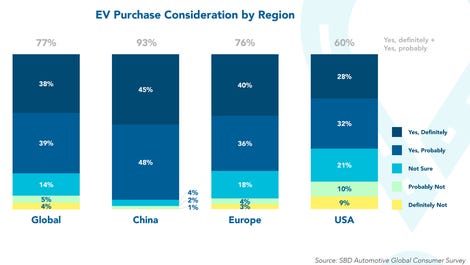
Consumers are ready to adopt electric vehicles
EV Owners have different motivations for buying their vehicles from various regions across the world. The top five reasons are: 1. environmental impact, 2. petrol/diesel cars are in decline and electric cars are the future, lower maintenance costs, 4. lower running costs, and 5. range of new technology that electric cars have in the cabin. The environmental impact from direct and indirect emissions has become a focal point in the fight against climate change and the transportation industry is working to address its 29% share of greenhouse gas emissions (Agriculture 10%, Commercial and Residential 13%, Industry 23%, Electricity 25% and Transportation 29% – the largest contributor of gas emissions).
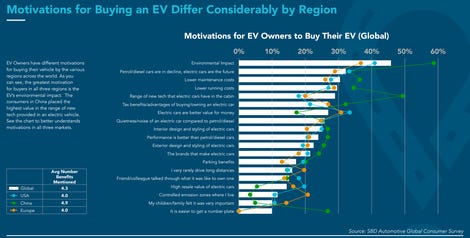
Motivation for buying an EV differs by geography
The environment and cost are foundations for EV adoption. The report notes: ” Many OEMs and suppliers are beginning to establish targets for carbon-neutral manufacturing and mitigate the organizational impact through downward pressure and process innovation. Public reporting and accountability will continue to impact consumer perception and many companies are beginning to publish lifecycle analyses and carbon footprint assessments on an annual basis.”
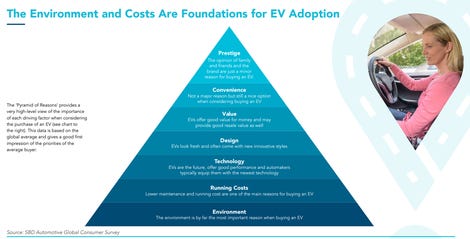
Environment and cost drive EV adoption
Benefits of ownership (ICE vs. EV owners)
An ICE (internal combustion engine) owner’s perception of EV trends towards ‘eco-friendly’ and ‘quiet’ as key benefits, while consumers who have already made the switch to an EV are more likely to identify in-vehicle technology, performance, and running costs as top benefits. The report also highlights the journey to an EV vehicle varies by geography. For example, 47% of current EV owners in Europe having owned a hybrid prior to their electric vehicle, compared to only 30% in the US and 16% in China. This means where hybrids are a ‘gateway product’ for European consumers, Chinese incentivization programs are helping ICE consumers make the transition straight to EVs.
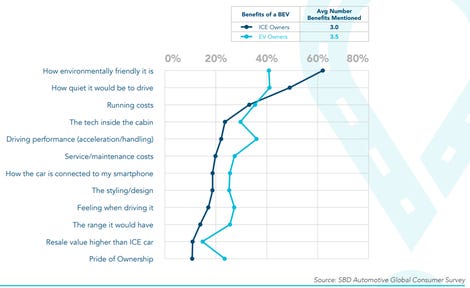
Benefits of ownership – traditional vs. EV ownership
Barriers to EV purchasing will change over time
Charging infrastructure requires continued development in both physical availability and the overall user experience, while range continues to be a leading concern voiced by consumers considering EVs. The top 10 barriers to EV purchase have modestly changed from 2019 to 2021. Over the past two years, the top 10 reported barriers to adoption have remained relatively consistent, though major differences include perceived performance issues with EVs in 2019 falling away, and the increasing concern of charging time, service and maintenance costs

2019 vs. 2021 barriers for adoption of electric vehicles
Lack of charging points is the biggest barrier for all consumers. Progress has been made in developing infrastructure and only one-in-five EV owners claim to charge infrastructure to be a barrier. However, lack of infrastructure, either actual or perceived, remains a key barrier to EV ownership as shown in this consumer survey data. According to the report, Tesla is leading the way in both range and battery size, reduce consumer concerns about EV adoption. Roughly two-thirds of American EVs don’t meet consumer expectations.
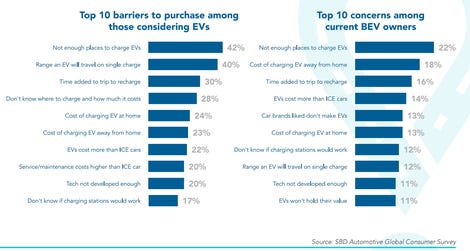
Charging infrastructure is the biggest barrier for EV adoption
Charging time is another key barrier that cannot be resolved in isolation, creating the need for more planning and time when embarking on long distance travel, especially in the US. This means long distance travel in an EV requires more planning and time. Traveling long distances in an EV can require 20%+ more time to incorporate charging and can also be more expensive if only using high-powered charging stations along the route.
The electrification experience is more than just the batteries
The EV ownership experience cycle includes many elements. The report highlights the need for a prospective EV owner to need more online assets and dealership training that goes beyond the traditional car-buying experience. For example, private and public charging experiences are completely new to most consumers. I own an electric vehicle and all of my charging experiences have been at home, in my garage. Fortunately for me, I do not drive long distances so I can simply charge my car when I am home, not having to worry about range or charging time.
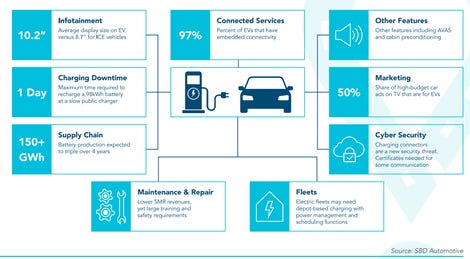
The dimensions of the EV consumer experience
The EPM advisory council’s reports by concluding that each ownership phase will be approached differently depending on an individual’s personality or persona.
The SBD Automotive Consumer Survey shows that even 50% of laggard consumers are already considering an EV, increasing steadily across the segmentation to 98% of early adopters. This clearly points to adoption as a question of when, rather than if someone will buy an EV. The report also highlights the dealership motivations that vary based on EV vs. ICE sales, which is mostly defined by the battery and the need to charge it.
The EPM report also highlights barriers for EV mass adoption including:
1. Hidden charging points
2. Complex charging pricing
3. Incomplete information to charging destinations
4. Inaccurate range calculations
The report also identifies cybersecurity threats as an area of interest. The report did highlight expected improved experiences with over-the-air (OTA) technology. ” As over-the-air (OTA) updates and the software-defined vehicle continue to advance in complexity and feature-centric design, new avenues are being forged to provide fresh and upgradable vehicle experiences,” EPM report.
To learn more about the Experience Per Mile Advisory Council report, please visit here.
For all the latest Technology News Click Here
For the latest news and updates, follow us on Google News.
